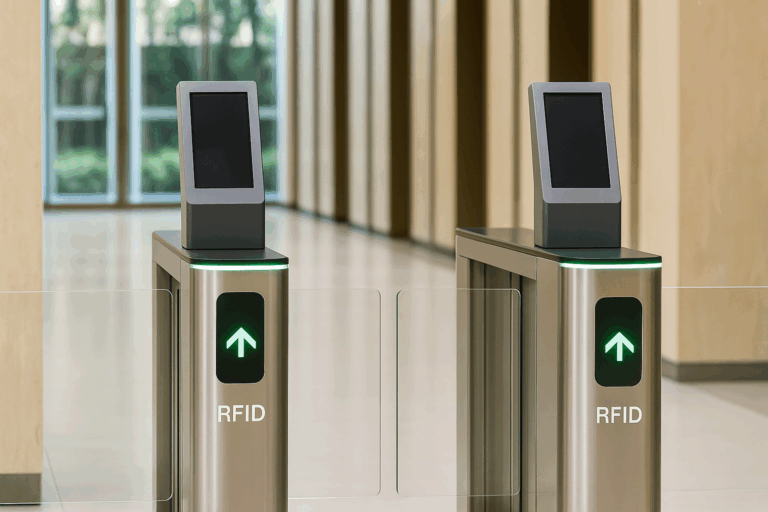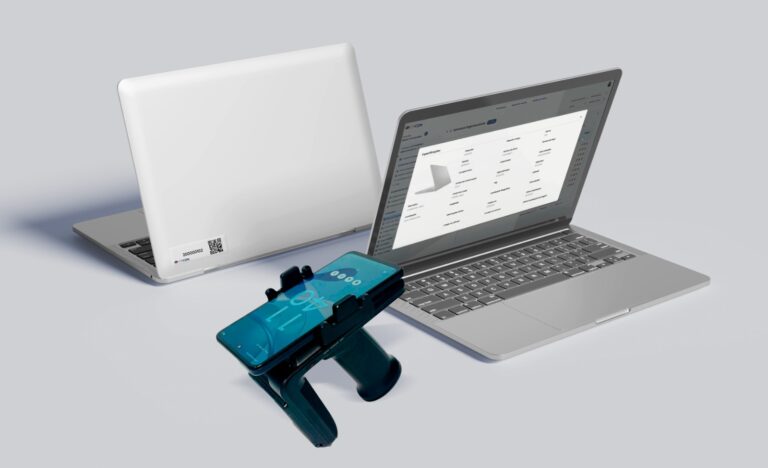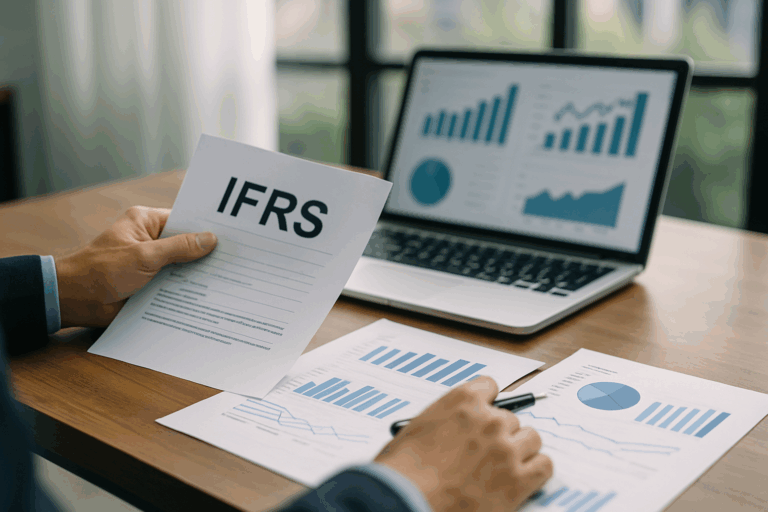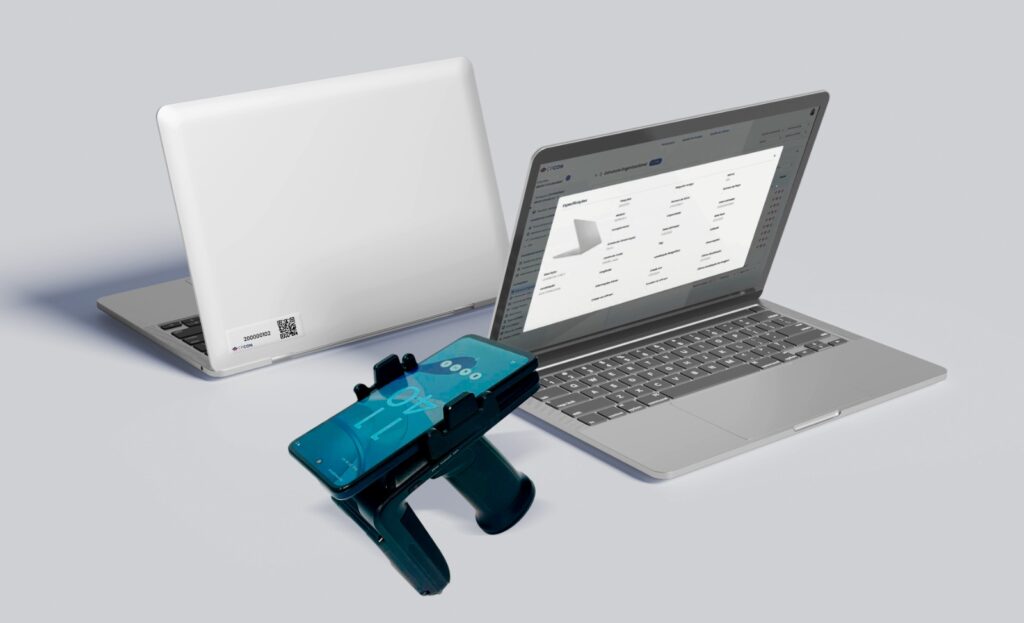Table of Contents
ToggleUnderstand the key principles, techniques, and real-world impacts of IFRS 13. A practical guide for finance leaders navigating fair value assessments.
In a global economy marked by volatility and increasing scrutiny, accurately determining the fair value of assets and liabilities has become a central challenge for finance leaders. IFRS 13 offers the framework that companies rely on to ensure consistency, transparency, and reliability in fair value measurement.
Originally introduced to unify global accounting practices, IFRS 13 now plays a critical role in risk management, investment decisions, and financial reporting. As interest rates fluctuate and markets respond to geopolitical pressures, the ability to measure fair value objectively is more than a compliance issue—it’s a strategic necessity. This guide explains how IFRS 13 works, why it matters today, and how organizations can apply it effectively to support confident, data-driven decisions.
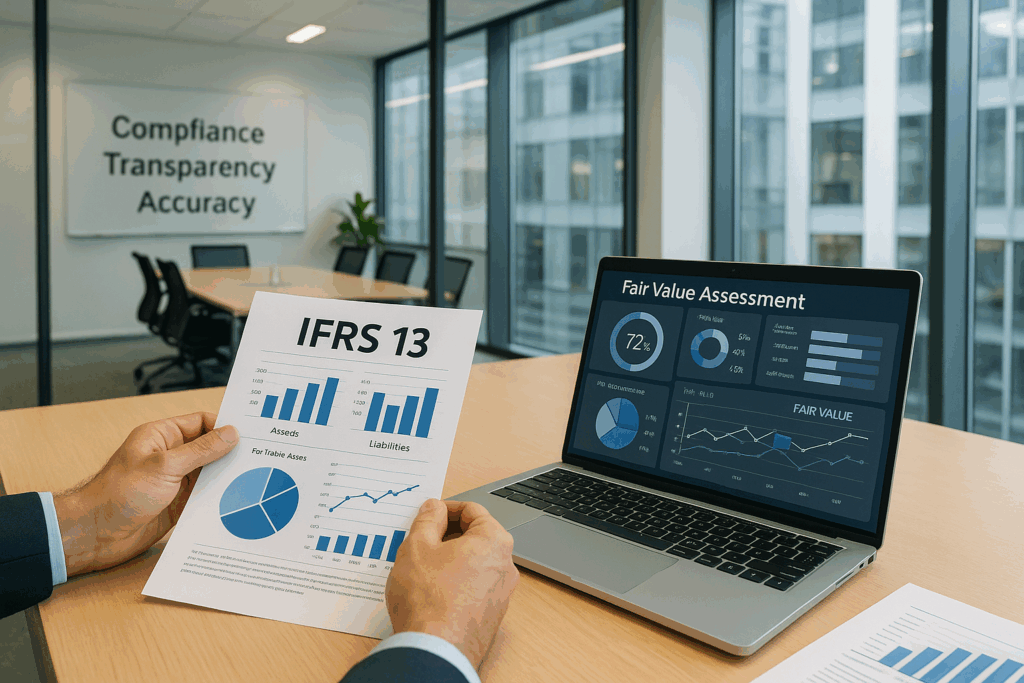
What is IFRS 13?
IFRS 13 is the international accounting standard that defines how companies must calculate and disclose the fair value of assets and liabilities. It doesn’t introduce new requirements for when fair value should be used—other standards decide that—but it does provide a single, consistent method for how fair value should be measured and reported.
At its core, fair value means the price an asset would sell for, or a liability could be transferred for, in a regular, non-forced transaction between market participants. IFRS 13 clarifies what “regular” and “market participants” mean, and outlines how to build a fair value estimate that reflects real economic conditions—not internal guesswork.
Since its release by the International Accounting Standards Board (IASB) in 2011, and implementation in 2013, IFRS 13 has helped more than 140 countries improve financial transparency. It brings together valuation methods that were once scattered across multiple standards, into a unified approach that applies to both financial and non-financial assets.
Today, the standard is more relevant than ever. Rising interest rates, inflationary pressures, and market uncertainty are making asset valuations more complex and volatile. Many companies are being forced to revisit how they apply IFRS 13, especially in areas like real estate, intangible assets, and long-term liabilities. In recent years, organizations such as the IFRS Foundation and global audit firms have published updated guidance to help entities deal with these new challenges, including how to use unobservable inputs when markets are inactive or distressed.
In simple terms, IFRS 13 helps companies speak the same language when they estimate what things are truly worth. And in today’s environment, that clarity isn’t just useful—it’s essential for trust, compliance, and smarter business decisions.
Who needs to comply with IFRS 13?
IFRS 13 applies to any organization that reports under International Financial Reporting Standards (IFRS). This includes public and private companies, multinational corporations, government entities, and non-profit institutions across more than 140 countries. If a company is required to measure assets or liabilities at fair value under any other IFRS standard—such as IFRS 9 (financial instruments), IFRS 16 (leases), or IAS 40 (investment property)—then it must apply the fair value principles established by IFRS 13.
The standard is industry-agnostic. Whether a business operates in real estate, manufacturing, financial services, energy, or technology, IFRS 13 ensures that fair value measurements are consistent and comparable across sectors.
More than a compliance tool, IFRS 13 also plays a strategic role in financial reporting. Investors, auditors, and regulators increasingly rely on fair value disclosures to assess risk, performance, and governance. A misstatement in fair value can have significant consequences, including audit findings, investor distrust, or impaired access to credit markets.
The IASB continues to reinforce the relevance of IFRS 13. In 2023, the IFRS Foundation published new materials to help preparers apply the standard in complex valuation scenarios, particularly where markets are illiquid or non-active. This includes guidance on using valuation techniques that rely on internal data and models, known as Level 3 inputs. You can explore this update directly on the IFRS Foundation’s official site.
In short, if your organization prepares IFRS-compliant financial statements and uses fair value in any part of the balance sheet or income statement, IFRS 13 is mandatory. More than that, understanding and applying it correctly is crucial to maintaining the integrity of your financial information and the trust of your stakeholders.
What is the difference between fair value and recoverable value?
While they may sound similar, fair value and recoverable value serve different purposes in financial reporting — and using them correctly is essential for compliance and transparency.
Fair value is the estimated price at which an asset could be sold, or a liability transferred, between willing and informed parties in an orderly transaction. This is the central concept in IFRS 13. Fair value is not based on how the company currently uses the asset, but rather on what the market would pay for it at that moment.
Recoverable value, on the other hand, is a concept used specifically for impairment testing, especially under IAS 36. It refers to the maximum amount a company can recover from an asset. This can be either:
- The asset’s fair value less costs to sell, or
- Its value in use, meaning the present value of expected future cash flows from using the asset.
In practical terms, fair value is used when you need to report what an asset is worth in the market, while recoverable value is used when you’re assessing whether that asset has lost value and needs to be written down.
Let’s take an example: Imagine a company owns a piece of machinery. Its fair value in the open market might be $100,000, but after accounting for selling costs, it would bring in only $90,000. Meanwhile, its value in use — based on future production and cash flow — might be $85,000. In this case, the recoverable amount is $90,000 (the higher of the two), and if the machine is recorded at $110,000 on the books, the company must recognize an impairment loss.
Understanding this distinction is especially important in volatile markets, where both fair value and future cash flow expectations may change rapidly. Misinterpreting these concepts can lead to misstatements in the balance sheet and a loss of stakeholder trust.
What factors affect the determination of fair value?
Determining fair value is not just about checking a price tag. It involves analyzing a mix of data, context, and professional judgment. The goal is to find a value that reflects what market participants would realistically pay or accept in an open and orderly transaction.
Here are the main factors that influence fair value:
Market conditions
Prices go up and down based on supply and demand. In a booming economy, assets may be worth more. During a downturn, prices tend to fall. Fair value must reflect this current market reality — not outdated or inflated numbers.
Economic environment
Changes in inflation, interest rates, or exchange rates directly impact how much an asset or liability is worth. For example, when interest rates rise, the present value of future cash flows tends to decrease — which can reduce the fair value of long-term investments.
Asset or liability characteristics
Not all assets are equal. Their value depends on:
- Condition: Is it new or used? Damaged or updated?
- Location: A building in a central business district is more valuable than one in a rural area.
- Restrictions: Some assets can’t be sold freely due to legal or contractual limits.
Timing of the valuation
Fair value is a snapshot in time. The same asset might have different values today and tomorrow — especially during periods of volatility. That’s why IFRS 13 requires entities to document the valuation date clearly.
Market data quality
Good decisions depend on good data. If the company relies on outdated, incomplete, or low-quality information, the fair value will be less reliable. The standard encourages the use of observable inputs — real market data from active sources — whenever available.
Industry-specific factors
Regulations, competition, and shifts in consumer behavior also influence fair value. For example:
- A change in environmental laws can reduce the value of industrial equipment.
- A new competitor may decrease the market value of a technology asset.
Internal performance indicators
Fair value can also be affected by the company’s own results. A brand-new factory might lose value if it’s underperforming or not aligned with business strategy. Market participants consider these aspects when estimating price.

Key concepts defined by IFRS 13
IFRS 13 introduces specific terms that help standardize how companies determine and explain the fair value of their assets and liabilities. These concepts are not apenas palavras técnicas — they shape how valuations are made and interpreted across different industries.
Let’s break down the most important ones:
Active market
An active market is one where assets or liabilities are traded frequently and in large volume. Prices are easy to observe and updated regularly.
Example: Shares of a listed company traded on a major stock exchange like the NYSE or B3.
In an active market, fair value is based directly on the last quoted price. There’s little need for judgment or estimation.
Exit price
The exit price is the amount a company would receive if it sold an asset, or the amount it would pay to transfer a liability. This is the perspective IFRS 13 requires — not the purchase price or the original cost.
Important detail: Fair value always reflects the market participant’s perspective, not the company’s internal plans or intentions.
Highest and best use
This concept applies to non-financial assets, like land, buildings, or equipment. It means the asset should be valued based on its most valuable use — as long as that use is:
- Physically possible
- Legally permitted
- Financially feasible
Example: A plot of land currently used for parking might be worth more if developed into a commercial building. Fair value would reflect that higher potential — not its current use.
Principal market vs. Most advantageous market
IFRS 13 requires that companies first look to the principal market — the one with the highest volume and activity for the asset.
If there’s no clear principal market, the next step is to find the most advantageous market — the one offering the best net price, after deducting transaction or transport costs.
Key takeaway: You cannot simply choose the most favorable market; you must follow this order of priority.
Market participants
These are buyers and sellers who:
- Are independent of each other
- Are knowledgeable and well-informed
- Have the ability and willingness to make a transaction
This concept helps remove bias. Valuations must reflect what the broader market would pay, not what one party (the company) would hope to gain.
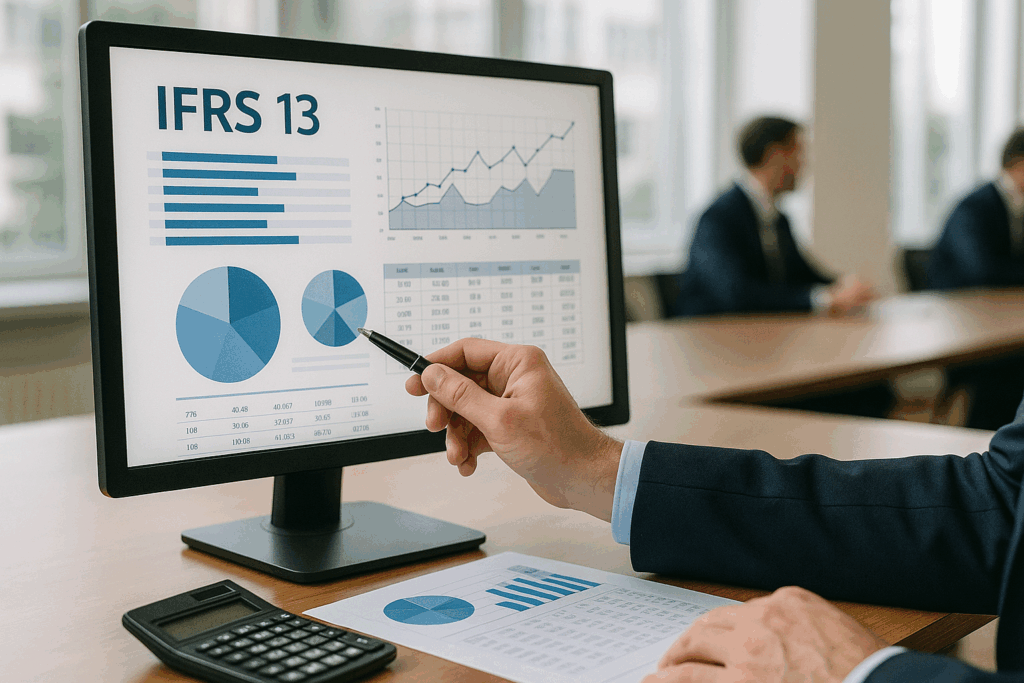
Understanding the Fair Value Hierarchy (Levels 1, 2 and 3)
To improve consistency and transparency in fair value measurement, IFRS 13 establishes a hierarchy of inputs — from the most objective to the most subjective. This structure helps companies determine which data should be prioritized when estimating the fair value of an asset or liability.
The key principle:
Use observable, market-based inputs whenever they’re available. Only rely on internal assumptions when no market data exists.
Level 1 – Quoted prices in active markets
These are prices from public markets for identical assets or liabilities, available at the measurement date.
Example:
Publicly traded shares on a stock exchange. If a company holds 10,000 shares valued at $15 each, the fair value is $150,000.
Why it matters:
This is the most reliable level, because no estimates or adjustments are required — just the direct market price.
Level 2 – Observable inputs other than Level 1
These inputs come from similar assets or liabilities, or other directly observable market data such as:
- Quoted prices for comparable assets
- Interest rates and yield curves
- Credit risk spreads
- Industry benchmarks
Example:
Valuing a corporate bond that isn’t traded daily, but has similar terms to another bond that is.
Why it matters:
Still based on market information, but requires adjustments and judgment to reflect differences.
Level 3 – Unobservable inputs
These are internal data points, such as the company’s own assumptions, models, or cash flow projections. They are used when no market data is available.
Example:
Valuing a patent, startup equity, or a highly specialized machine with no recent sales or comparable market prices.
Why it matters:
This level requires the highest degree of professional judgment and documentation. The valuation must reflect what a market participant would reasonably assume — not just internal expectations.
Together, these levels ensure that fair value reflects the most relevant and reliable information available. IFRS 13 encourages companies to move down the hierarchy only when higher-level data isn’t accessible, and to be transparent about how each input level was used.
How to apply IFRS 13 in practice: requirements and valuation techniques
IFRS 13 goes beyond simply defining what fair value means. It also sets out a clear framework for how to apply that definition in real-world situations, using consistent and market-aligned methods.
To apply IFRS 13 correctly, companies need to follow two essential steps:
- Understand the specific characteristics of the asset or liability being measured
- Select the most appropriate valuation technique based on those characteristics and market data
Let’s break each part down.
Key requirements for determining fair value
Before selecting a method, IFRS 13 requires companies to evaluate several critical elements:
Characteristics of the asset or liability
- Condition: A worn or outdated asset typically holds less value, even if similar newer items are worth more.
- Location: Market value may vary significantly based on where the asset is located.
- Restrictions: Legal or operational limits on use or sale can directly reduce an asset’s fair value.
Market perspective
Fair value must reflect how market participants would price the asset or liability — not how the company internally values it. Even if a business uses internal models (Level 3 inputs), the logic must align with external market behavior and assumptions.
Use of relevant inputs
Whenever possible, companies should prioritize observable inputs such as market quotes, transaction data, or indices. If such data is unavailable, unobservable inputs may be used — but they must be well-documented, supportable, and transparently disclosed.
The three main valuation techniques
Once the relevant data has been assessed, IFRS 13 allows companies to choose from three generally accepted valuation techniques. Each has its strengths depending on the asset’s nature and the availability of market information.
Market Approach
This approach determines fair value based on actual prices from market transactions involving identical or comparable assets or liabilities.
Best used when:
- A liquid market exists with similar items
- Recent transaction data is accessible and reliable
Example: Estimating the value of a commercial building by comparing it to similar properties recently sold in the same area.
Income Approach
This method estimates value based on the present value of future expected economic benefits, such as income or cost savings. It typically involves projecting cash flows and applying a discount rate to reflect risk and time value.
Best used when:
- The asset generates future income or cash flows
- Forecasts are reliable and a proper discount rate can be applied
Example: Valuing a subscription-based software license using a Discounted Cash Flow (DCF) model.
Cost Approach
The cost approach is based on what it would cost to rebuild or replace the asset, minus any depreciation, obsolescence, or deterioration.
Best used when:
- The asset is specialized or lacks market comparables
- It was recently acquired or developed
Example: Valuing custom manufacturing equipment by estimating its replacement cost today, then subtracting physical wear and technological obsolescence.
Choosing the right technique
There is no universal method that fits every case. The decision depends on:
- The type of asset or liability
- The quality and availability of market data
- The method that provides the most relevant and reliable result
In practice, many companies use a combination of techniques to cross-check values and support internal controls. The goal is always to provide a fair value that reflects current market reality, backed by solid evidence and sound reasoning.
IFRS 13 vs. ASC 820: What’s the difference?
IFRS 13 and ASC 820 share the same goal: to define how fair value should be measured and disclosed in financial reporting. Both standards offer a structured approach for valuing assets and liabilities based on current market conditions.
However, despite their alignment, there are key differences in terminology, emphasis, and application that companies need to understand — especially those operating across international borders.
What is ASC 820?
ASC 820, also known as the “Fair Value Measurement” standard under US GAAP (Generally Accepted Accounting Principles), provides similar guidance to IFRS 13. It defines fair value as:
“The price that would be received to sell an asset or paid to transfer a liability in an orderly transaction between market participants at the measurement date.”
This definition is nearly identical to IFRS 13. Both standards require the use of a market-based measurement, not an entity-specific one, and both adopt a three-level input hierarchy.
Key similarities
- Definition of fair value: Both use the concept of an “exit price” based on orderly transactions between market participants.
- Fair value hierarchy: Levels 1, 2, and 3 are consistent in both frameworks, emphasizing observable inputs over unobservable ones.
- Valuation techniques: Market, income, and cost approaches are recognized in both standards.
- Disclosure requirements: Both require detailed disclosures about valuation methods and inputs, particularly for Level 3 measurements.
Key differences
Application of “highest and best use”
- Under IFRS 13, the fair value of non-financial assets must reflect their highest and best use, even if the entity doesn’t currently use them that way.
- Under ASC 820, the default is the asset’s current use, unless there is clear evidence supporting a different use that’s legally and economically feasible.
Guidance detail
- IFRS 13 offers more explicit guidance on identifying the principal market and determining valuation inputs.
- ASC 820 provides slightly more flexibility, allowing entities to use judgment when observable data is limited.
Jurisdiction and scope
- ASC 820 is part of the US GAAP system and applies primarily in the United States.
- IFRS 13 is part of the international IFRS framework and is used in over 140 countries.
Why this matters
For global organizations, these differences can lead to variations in reported asset values — even when the underlying economic conditions are the same. Companies that report under both IFRS and US GAAP need to ensure they understand how each standard impacts valuation, disclosures, and internal controls.
A misalignment between the two can also affect:
- Investor confidence
- Audit outcomes
- Compliance with cross-border regulations
For a practical summary of IFRS vs. US GAAP on fair value, you can refer to the IFRS Foundation comparison tools and the FASB’s ASC 820 guidance.
Conclusion
In a world where business decisions depend increasingly on reliable financial data, IFRS 13 offers a clear and consistent framework for measuring fair value. Whether you’re valuing financial instruments, real estate, or intangible assets, the standard helps ensure that your reporting reflects true market conditions — not outdated costs or internal assumptions.
But applying IFRS 13 is more than a technical requirement. It’s a strategic tool. It strengthens investor trust, improves transparency, and supports smarter, data-driven decisions across the organization.
Companies that invest in accurate fair value measurement — and that understand how to interpret Levels 1, 2, and 3 inputs — are not just compliant. They are more resilient, better prepared for audits, and more attractive to stakeholders.
Ready to strengthen your fair value strategy?
👉 Contact our specialists and request a customized consultation.
FAQ
What is the main purpose of IFRS 13?
The primary goal of IFRS 13 is to standardize how companies measure and disclose fair value across all financial and non-financial assets and liabilities. It creates a single framework that improves comparability and transparency in financial reporting.
What types of assets are covered by IFRS 13?
IFRS 13 applies to any asset or liability that another IFRS standard requires to be measured at fair value. This includes:
- Financial instruments (e.g., stocks, bonds, derivatives)
- Investment properties
- Intangible assets
- Equipment and real estate in business combinations
How does IFRS 13 define fair value?
Fair value is defined as the price received to sell an asset or paid to transfer a liability in an orderly transaction between market participants on the measurement date. It reflects market-based, not entity-specific, assumptions.
What are the risks of not applying IFRS 13 correctly?
Inaccurate fair value measurements can lead to:
- Misstatements in financial statements
- Audit findings or regulatory scrutiny
- Loss of investor confidence
- Strategic misalignment and poor decision-making
Using outdated data or relying too heavily on internal models without justification increases compliance risk.
What is the difference between IFRS 13 and ASC 820?
Both standards define fair value similarly and use a three-level input hierarchy. However:
- IFRS 13 requires fair value to reflect the asset’s highest and best use
- ASC 820 focuses on the asset’s current use unless a better alternative is clearly evident
They also differ slightly in how they define the principal market and how much guidance they provide.
This article by CPCON presents a clear and practical guide to IFRS 13, the standard that defines how to measure and report the fair value of assets and liabilities. It explains how the fair value concept works, when and how to apply it, and what companies need to consider when valuing different types of assets. The text explores the three-level input hierarchy, the main valuation techniques (market, income, and cost), and the key requirements for ensuring transparency and accuracy. It also compares IFRS 13 with ASC 820 and includes real-world examples, frequently asked questions, and expert insights. Designed to be easy to follow, this content helps businesses apply IFRS 13 with confidence and stay aligned with international best practices—positioning CPCON as a global leader in asset valuation and financial compliance.
Get to Know CPCON Group: A global expert in asset management and inventory solutions
CPCON Group is a global leader in asset management, fixed asset control, and RFID technology. With over 25 years of experience, we have supported major companies such as Nestlé, Pfizer, Scania, BASF, Coca-Cola Andina, Vale, Vivo, Petrobras, and Caixa in high-complexity projects.
Curious about our global footprint? We are present in:
- North America: Toronto, New York, Miami, Minneapolis, Seattle, Dallas
- Latin America: São Paulo, Buenos Aires, Lima, Bogotá, Mexico City
- Europe: Lisbon, Porto, London, Birmingham, Milan, Rome, Turin, Madrid, Bilbao
- Middle East: Dubai, Saudi Arabi
- Caribbean: Tortola, Grand Cayman
Follow our LinkedIn Showcase Page and stay updated with strategic content on asset control, inventory management, and RFID innovation across industries.



